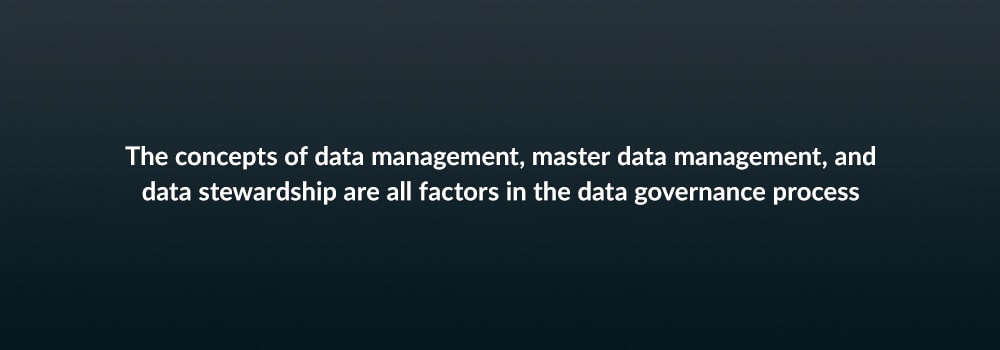What is data governance?
There's a higher premium on information than ever before, and digital content is what it's all about. Industry analysts project the volume of data created worldwide will rise exponentially from 79 zettabytes in 2021 to 181 zettabytes by 2025. For context, one zettabyte is enough to store 7.5 trillion MP3 songs. That's a lot of information.
With such a drastic rise in data production comes increased security risks and a heightened need for organization. Establishing a data governance policy can help your workplace better manage your data and all your content while you keep work moving.
What is data governance?
Data governance refers to the processes an organization follows to create and maintain one secure, unified set of data for the entire enterprise.
The concepts of data management, master data management, and data stewardship are all factors in the data governance process. Here's how to differentiate between them.
Data management
Though data governance is an essential component of data management, they're two separate concepts. Data management is directly involved with data in a hands-on way, while data governance lays out the higher-level framework for how to manage data.
Master data management
Data governance makes master data management (MDM) possible. You can establish a single "master" source using a data governance strategy. Once you've found the correct master data, MDM takes over, reconciling multiple data sources into one unified view to determine the official version.
Having identified the single trustworthy data source, your organization will use your governance strategy to ensure its correct usage and prevent errors from entering the data.
Data stewardship
Traditionally, a steward is a staff member who manages household concerns on an estate, like collecting rent, keeping accounts, and supervising staff. Similarly, a data steward is someone in charge of managing data-related tasks, such as ensuring all data is accurate and accessible to the appropriate parties.
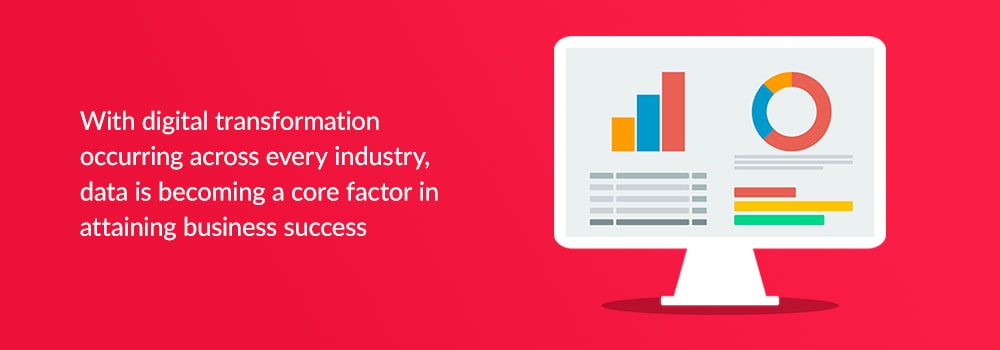
Why does data governance matter?
With digital transformation occurring across every industry, data is becoming a core factor in attaining business success. Here are a few reasons data governance has become critical to every kind of business.
- In general, the global shift toward digital business practices demonstrates a substantial need for data governance
- As technological advances like machine learning and AI become more mainstream, so will data governance, since these programs rely on effective governance
- With many companies moving to cloud-based storage systems, data governance and master datasets become even more necessary, because companies need accurate, reliable information for all their processes
The need for data governance speaks for itself. But we can get even more specific about goals and benefits.
Goals and benefits of data governance
Your data governance strategy goals will be unique to your organization, but some of them tend to be consistent across the board.
Goal: Eliminate data silos
The fundamental aim of any data governance strategy is to break down and eliminate data silos, which can cause fragmented and contradictory data across an organization.
Data silos are stores of data that are only available to specific people or departments within an organization. They typically happen accidentally, often due to structural or technological limitations. For example, departments that don't cooperate to share datasets and use the same technology platforms can easily end up with different versions of single documents, creating version-control issues and making it nearly impossible to govern content.
Allowing data silos to exist can cause exponential data growth in storage space that only a few people can access, which translates to bloated costs in terms of file storage. When there are two or more versions of the same dataset, similar or duplicate data takes up valuable space.
Creating a data governance strategy can help clear up that space and set the stage for effective data management.
Goal: Streamline your digital transformation
Your data governance strategy has the power to transform every part of your business. Having a comprehensive plan streamlines your digital conversion with:
- Easier integration of automated manufacturing processes
- Assistance in meeting evolving legal requirements
- More practical insight on your customers
- Consistent and accurate reporting that helps protect your financial information
- Simple ways to move to the cloud
By integrating technology into your workplace, you inevitably create more data. Solid governance and management policies establish a framework for your conversion so you can increase your productivity in the digital age.
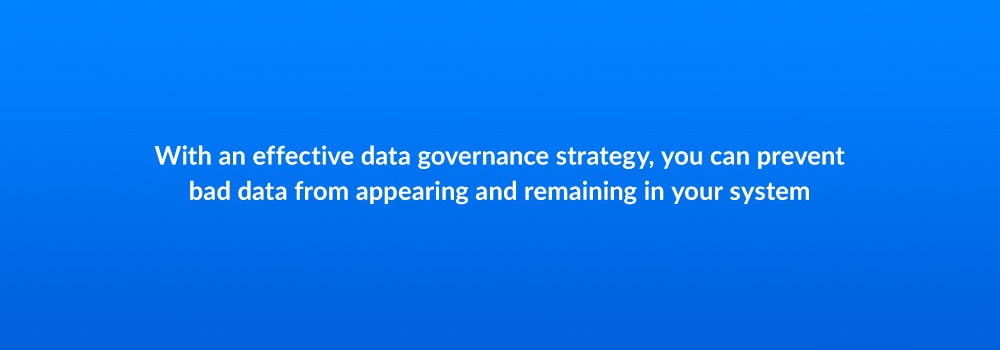
Goal: Eliminate risk
Data governance ensures your data is consistently reliable and accurate by establishing one trustworthy source. It also prevents data misuse from employees and representatives. With an effective data governance strategy, you can prevent bad data – for example, data that isn't consistent with your organization's formatting standards – from appearing and remaining in your system.
This strategy can also improve data security, enabling you to monitor your data usage and enforce policies when violations occur. With fewer risks, it's easier to comply with government and industry regulations such as the Health Insurance Portability and Accountability Act or the Payment Card Industry Data Security Standards.
Who's responsible for data governance?
Data governance strategies rely on multiple levels of leadership and various types of employees to function, from top tech executives to the data owners. A concerted effort to manage and maintain the data is necessary for any good governance scheme. Regardless of how you choose to implement a data governance strategy, you'll need to involve the employees who are in charge of managing data.
Within an organization, data owners are the people involved in overseeing and protecting specific assigned datasets. They establish who may access, use, and edit that data.
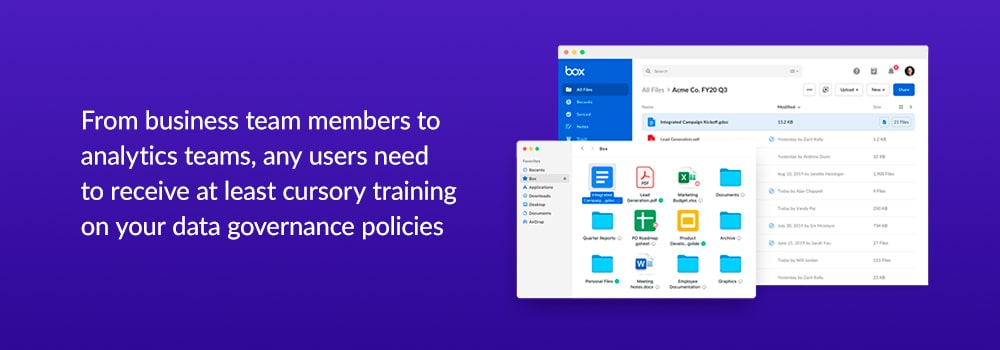
Data governance structure
Here's an outline of a typical data governance hierarchy, but every company is different.
The chief data officer (CDO) is often the most senior executive concerned with your data governance program – the person securing funding and building your program's foundation.
A data governance manager – who may or may not be the same person as the CDO – oversees implementing and maintaining the strategy.
The data governance committee makes ongoing decisions regarding data policy and standards and typically consists of executives and other data owners. Data analysts, data architects, and engineers will work with the committee to analyze and track essential metrics and ensure things look right moving forward.
Data stewards directly engage with data in your organization and are responsible for implementing your committee's governance policies and evaluating compliance.
Data stewardship can be a full-time position or a part-time job, based on your company's nature. The people who work as data stewards can also vary. You can allow data owners to tend to their data directly, or delegate this to other IT or business professionals.
From business team members to analytics teams, any users need to receive at least cursory training on your data governance policies. By providing this training, you can prevent accidents like misuse of data or security breaches.
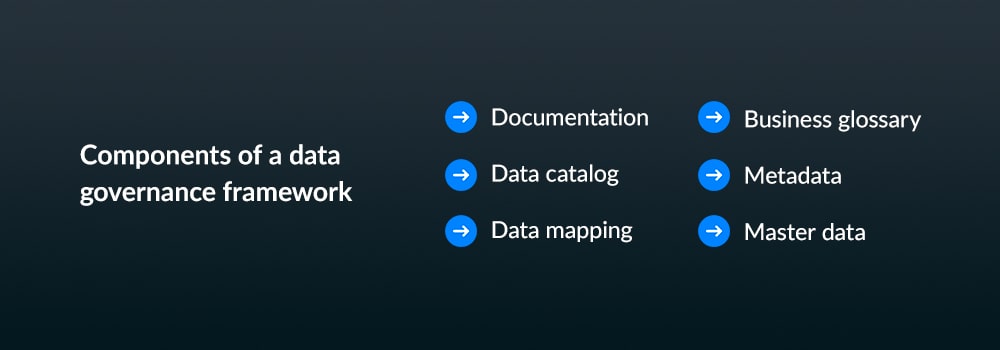
Components of a data governance framework
Your strategy should start with a written mission statement or constitution that outlines your organization's goals for its data. What do you want to accomplish with this strategy? How will you measure your goals? Detail every aspect of the process in this document and make the framework accessible to everyone involved with the data.
Documentation
Documentation is vital at every stage in the process because it provides an easy reference point for your organization. Whenever you feel your strategy could use some fine-tuning, referring to your documented procedures can help you quickly pinpoint what you need to change and where to make the change.
Accessible documentation can also provide an easy way for employees involved in data operations to find processes. Clear directions will keep your organization on track with its governance strategy.
Data catalog
Curate an inventory of available data, including metadata like search functions, data lineage, collaboration tools, file types, and any other characteristic that's relevant to the information you have.
Data mapping
By mapping out your data, you can visualize how data moves through your organization and how that flow can affect its condition. Once you have a map created, you can categorize data based on sensitivity. These categories will influence how each dataset fits into your data governance plan.
Business glossary
Create a glossary containing definitions of terms and concepts necessary to your organization. Establishing a shared vocabulary can help prevent misunderstandings and make your governance efforts more effective.
Metadata
This term refers to data that describes other data. For instance, if the data is a photo of a cat, examples of metadata include the file type, any tags or keywords, and the image's usage rights.
Master data
The codified, authoritative source of data that you deemed crucial to your data governance strategy.
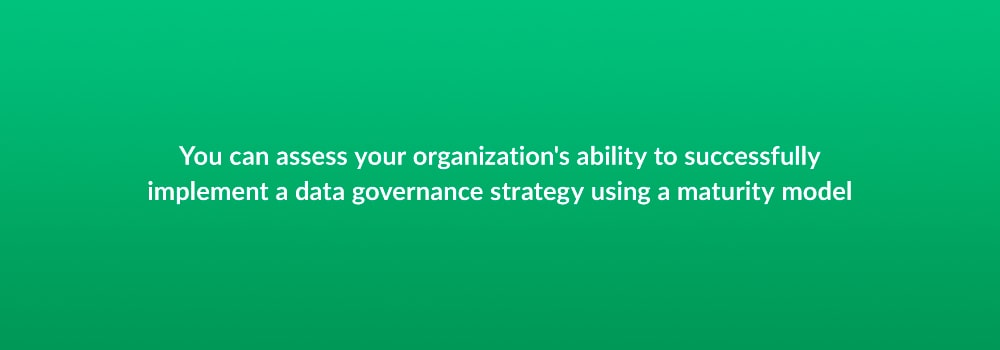
Data governance implementation with a maturity model
The first step to implementing a data governance strategy is identifying who owns what data. These individuals must take an active role in creating a smooth, streamlined data governance strategy, because they're the ones who have ultimate control over the data. So even while your CDO or governance manager should lead the process of creating the program, having buy-in from the data owners is critical to success.
You can assess your organization's ability to successfully implement a data governance strategy using a maturity model. This model examines the varying levels of awareness and user buy-in throughout your organization, providing insight into how you should plan to get a strategy off the ground.
The standard breaks down into five phases based on the awareness levels within your organization.
Maturity level 0: Unaware
In this phase, you might not have much support for a governance strategy. Executives may not yet see the need for such an endeavor because existing workarounds are functioning "well enough." At this stage, your best move is consistent and diplomatic advocacy for a better strategy. Point out that the workarounds are only a Band-Aid and that data governance will produce a more reliable result.
Maturity level 1: Initial
Any processes in place in this phase are likely sporadic and incomplete. Influential individuals realize that more effective policies are necessary to repeat previous successes. It's your role to convince your staff of your strategy's necessity.
Maturity level 2: Reactive
In this phase, the framework for a comprehensive strategy is more stable. You can implement basic management procedures to prepare your enterprise for the journey of planning a complete governance strategy.
Maturity level 3: Proactive
Procedures in this phase are increasingly advanced and consistent across your organization. You have a unified approach to managing data, and buy-in has increased substantially.
Maturity level 4: Managed
Businesses that have reached level four see data governance as an established, necessary part of doing business. There is still room for improvement, but the process is well underway.
Maturity level 5: Optimized
Your data governance strategy has been in operation for a while.
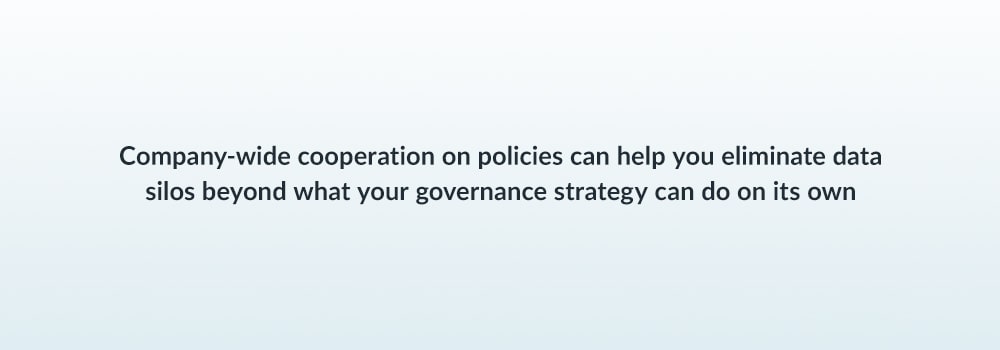
Best practices for managing data governance initiatives
It's critical to prioritize user buy-in within your organization. Get data owners involved with creating policies and emphasize company-wide cooperation on policies as well. These steps can help you eliminate data silos beyond what your governance strategy can do on its own. If you can convince your employees, you'll have a much easier time with the change management process.
Data governance challenges
For some organizations, obtaining funding for a data governance program is a significant hurdle, but other challenges include the following.
No business glossary
Terms will inevitably vary across departments, so it's necessary to compile a glossary of standard terms and uses. Without a shared language, your organization may experience confusion.
Sporadic implementation
If only some parts of your organization adopt your data governance policy, issues like security breaches and duplicate files can arise.
Implementation must involve your whole enterprise, rather than select branches. If parts of your organization are hesitant to adopt the policy, you may need to develop an adoption strategy.
Document instances where things have gone wrong in the past due to your lack of data governance. Show how the outcomes of these situations affected your organization's goals, then present an alternative scenario to demonstrate how the situation could have turned out had there been a management strategy in place.
No designated data steward
If your organization does not have a specific individual or group who administers and manages data, you need to appoint someone. Having a designated data steward is paramount to enacting an effective governance strategy.
Too many data stewards
Your organization only needs one person or team to perform this function. If there is more than one data stewardship team, communication between each group can become spotty. This disconnect can result in confusion across departments and even lost or incorrectly deleted data.
Lack of communication
Like any policy change, you need to ensure that everyone is on the same page while implementing your data governance strategy. Provide training for any staff member involved with handling data in every department and management level. Additionally, make sure to have your CDO check in frequently to address any misconceptions, at least at first.
Unclear data stewardship protocol
Your procedures for handling and organizing data should be easy to understand. Training can help clear up some confusion, but you may need to revisit your governance protocols if there is a wide-scale issue. With sufficient documentation, you should find a way to reword or clarify your procedure so it's less challenging to understand.
However, if it's an ineffective procedure, additional revisions may be necessary. You can work with your data governance committee to create a more functional solution.
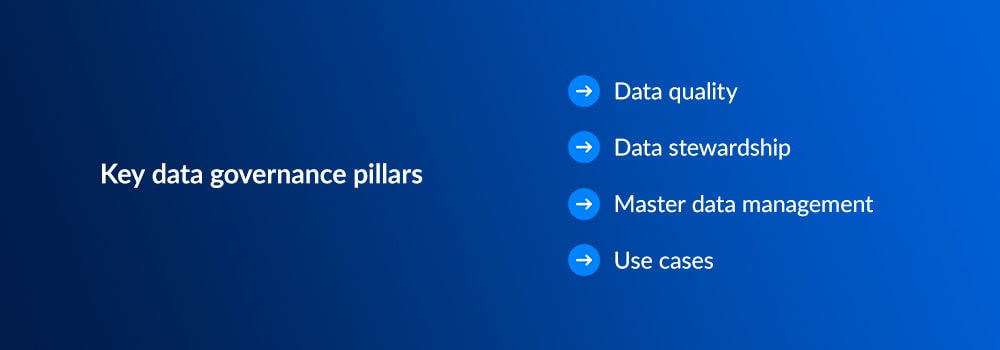
Key data governance pillars
There are four pillars to any data governance strategy.
1. Data quality
Your data governance strategy could be the world's most effective system, but you still need data for it to make sense. Good data is accurate, complete, and consistent across all systems. Regularly disposing of low-quality data helps ensure you are only storing relevant information.
2. Data stewardship
Once you amass data, you need people to curate it and ensure it's accurate. You can automate some of these tasks with technology, but having people designated for the job is also an intelligent measure.
3. Master data management
MDM establishes the master set of data for all entities, ensuring consistency across your organization. This master set of data is the most complete version of the data collected by each department, which is why it's so crucial to maintain.
Once you've established your master data, that's when your data governance system comes into play. It will prevent data errors from occurring and maintain master data quality.
4. Use cases
A use case is a specific application of a dataset to an organization's needs. For instance, preventing a data breach would be one use case. Enabling an AI would be another. Your organization's needs will likely be different, but it is essential to begin each new project with your use case in mind.
Box's approach to data governance
At Box, our platform makes designing, maintaining, and streamlining your governance strategy a smooth, straightforward process, with the built-in ability to control your data. Ensure compliance with government and industry standards while maintaining high productivity rates. Here's how.
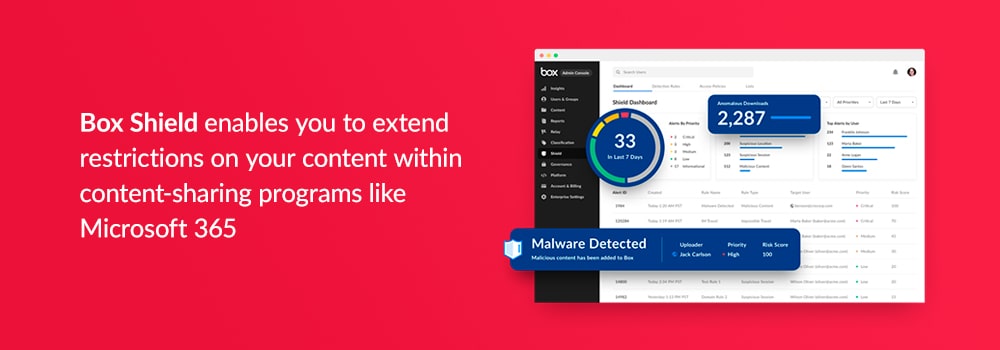
Complete control of all data
With Box, you have total control over what happens to your data.
Box Shield enables you to extend restrictions on your content within content-sharing programs like Microsoft 365. For example, if you need to prevent people from downloading and printing specific Microsoft documents, Box Shield makes it possible.
If someone accidentally deletes an earlier version of a file, you can get it back. Box enables unlimited versions of all files, so you can preserve and restore what you need.
Whenever you no longer need a piece of content, Box helps you effectively and securely dispose of it. Our advanced trash control feature puts the power in your hands by granting permanent file deletion permissions to anyone you choose.
Frictionless security
Cloud-stored data is crucial to data governance success. With our advanced security controls and integrations across existing security programs, you can lock down files without sacrificing productivity.
Advanced malware detection helps reduce risks by scanning active content throughout uploads, downloads, and sharing. You get a robust layer of security that harmful programs can't breach, and you'll receive timely alerts on suspicious activity and potential attacks.
Seamless integration
Box is compatible with more than 1,500 apps, including Microsoft 365, McAfee, Slack, Adobe, and Google Workspace. Having an open platform allows Box to adapt to meet the needs of any workplace as work changes and evolves to become more digital. Learn more about all our integrations here.
Transform your data governance strategy with Box
If you're undergoing digital transformation or looking into creating a data governance structure, learn why Box is the best platform for your organization. Our seamless, intuitive program will keep your data safe and secure while still allowing you to keep control of your information.
Interested in taking the next step? Learn more about what we offer, or contact our sales team today for a free demo.
**While we maintain our steadfast commitment to offering products and services with best-in-class privacy, security, and compliance, the information provided in this blogpost is not intended to constitute legal advice. We strongly encourage prospective and current customers to perform their own due diligence when assessing compliance with applicable laws.
